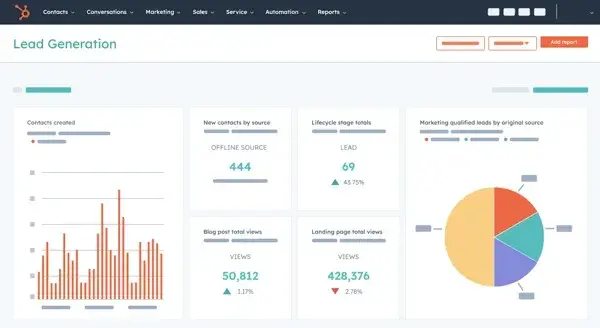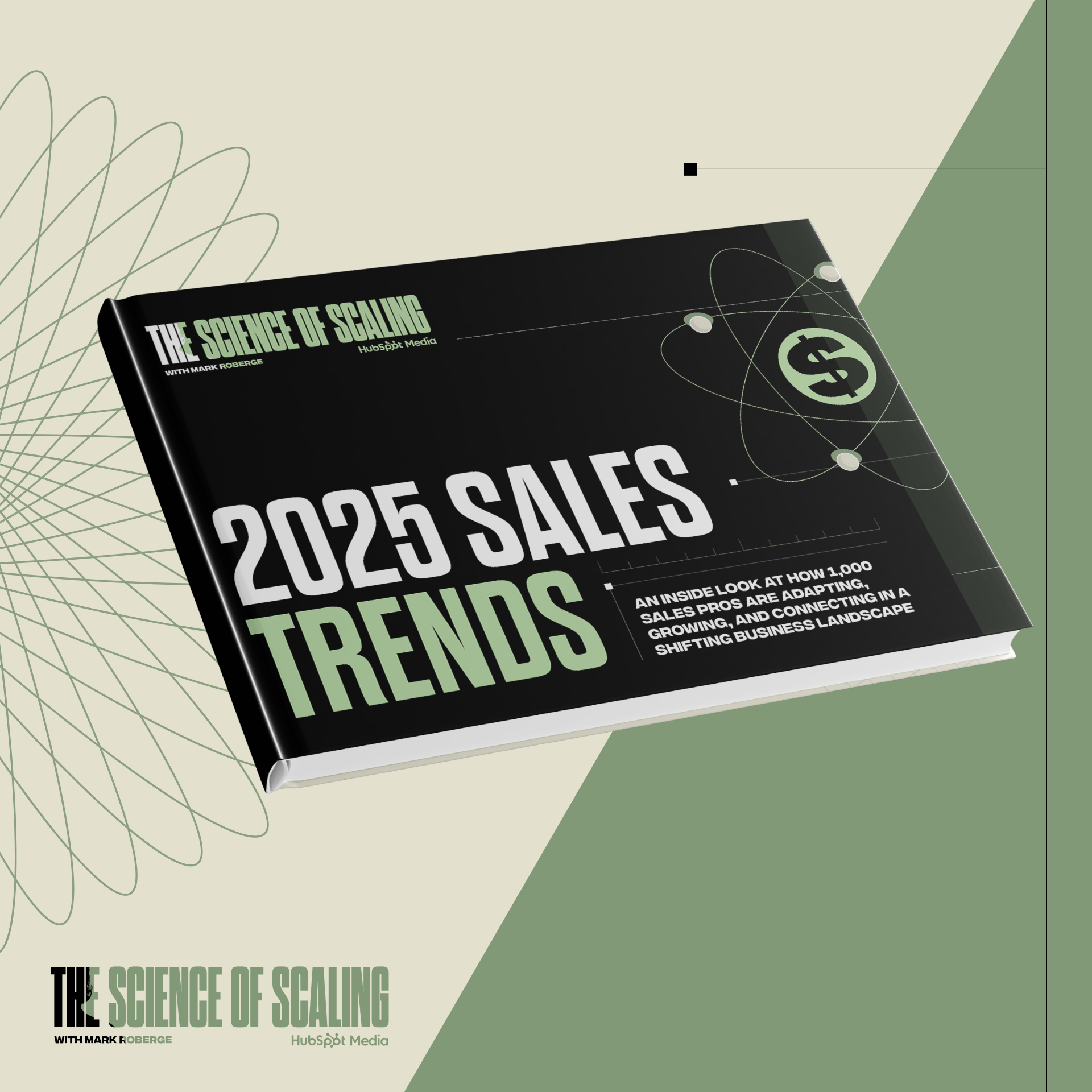Table of Contents
- Types of Data a Sales Team Should Track
- Sales Data
- How to Analyze Sales Data
- Data-Driven Sales
- How to Develop a Data-Driven Sales Strategy
- Building a Data-Driven Sales Team
- Sales Data Helps You Grow Better
Sales Data
Data is an indispensable component of successful sales teams. Sales data can help representatives avoid pursuing bad-fit customers, and it can inform new opportunities that sales teams wouldn’t detect otherwise.
However, data on its own can be intimidating, especially for teams that are getting used to such an analytical culture. I’ve also seen sales teams that avoid their own data like the plague, afraid that if they look too closely, they might not like what they find.
That being said, sales teams don’t need to make use of every single metric. Some data just exists without providing insights, and that’s fine. Before I dive into the types of sales data your team should track, let’s start with how to approach sales data so it benefits your team and company goals.
How to Approach Sales Data
When I’m working with a sales and marketing team on performance tracking, I always start with business objective(s). This step isn’t about what data can do for you; it’s about the goals within your business. So, I recommend focusing on what you want for your sales team.
Example: We want to shorten our sales cycle in Q2.
Next, I make a note of what questions arise from the objective.
Example: How long is our current sales cycle? What’s causing it to be at this length? How long would we like it to be? How much money would this save us? What do we need to shorten the current sales cycle?
Finally, I identify which sales metrics are needed to answer these questions. (I’ll cover the types of sales data below.)
Now, the sales team should know which specific sales metrics to leverage as we work to meet the objective. Over time, as the objectives change, I may need to add or remove various data points based on need.
The following section will cover the types of data your team should know.
Types of Data a Sales Team Should Track
- Total revenue
- Total sales by time period
- Sales by lead source
- Revenue per sale
- Revenue by product
- Market penetration
- Sales per prior activity
- Percentage of revenue from new business
- Percentage of revenue from existing customers
- Year-over-year (YOY) growth
- Average customer lifetime value (LTV)
- Net Promoter Score (NPS)
- Number of sales lost to competition
- Percentage of sales reps attaining 100% quota
- Revenue by territory
- Revenue by market
- Cost of selling as a percentage of revenue generated
In this section, I cover the most common sales key performance indicators (KPIs). These are important for covering company-wide performance as well as tracking how your sales team is impacting your broader company goals. Let’s look at them in more detail in the following chart. I’ll talk about how to actually collect this data later.
For a list of over 50 sales metrics, as well as a breakdown of sales KPIs per team type, check out our Ultimate Guide to Sales Metrics.
|
Sales KPI |
What It Tells You |
|
Total Revenue |
How much revenue your sales team is generating |
|
Total Sales by Time Period |
How your sales team is performing (i.e., improving or worsening) over time |
|
Sales by Lead Source |
Where your sales are coming from and what lead generation sources are or are not working |
|
Revenue per Sale |
How much revenue is generated by each sale you make |
|
Revenue by Product |
How much revenue is generated by each product, product line, or service that you sell |
|
Market Penetration |
How much your product or service is being used by customers as compared to the total estimated market |
|
Sales per Prior Activity |
How many sales were made for each prior activity (e.g., phone calls, email outreach, in-person meetings, etc.) |
|
Percentage of Revenue from New Business |
How much revenue is generated from brand-new customers |
|
Percentage of Revenue from Existing Customers |
How much revenue is generated from existing customers (i.e., cross-selling, upselling, repeat orders, expanded contracts, etc.) |
|
Year-over-Year (YOY) Growth |
How your sales team performance is growing as compared to the previous year |
|
How much revenue you can expect one customer to generate throughout your business relationship |
|
|
Net Promoter Score® (NPS) |
The degree to which people (i.e., your customers) would recommend your company to others |
|
Number of Sales Lost to Competition |
How many sales in a given time period are lost to competition |
|
Percentage of Reps Attaining 100% Quota |
How many representatives on your team are attaining 100% of their quota |
|
Revenue by Territory |
How much revenue your sales team is generating by territory |
|
Revenue by Market |
How much revenue your sales team is generating by market |
|
Cost of Selling as a Percentage of Revenue Generated |
How much your company is paying to generate sales |
How to Analyze Sales Data
So, I’ve identified an objective and tracked several KPIs to measure progress — now it’s time to analyze the data.
Once I have sales data in order, it’s good practice to present the findings visually. Charts, graphs, and dashboards make it easier to understand the information, enabling the team to spot trends, patterns, and correlations within the data. It also provides an opportunity to detect any outliers that require further investigation.
For example, HubSpot’s sales dashboard gives users a birds-eye view of their sales performance, allowing them to track key metrics like revenue, sales by lead source, and year-over-year growth.

HubSpot’s Sales Reporting & Performance Dashboard
Armed with these insights, you can take actionable steps to optimize your sales performance and make informed business decisions.
Next, I’ll discuss how to build a data-driven strategy and sales team.
Data-Driven Sales
Data-driven sales is a sales approach that involves collecting and using specific metrics to inform all sales decisions, from lead prospecting to people management to churn reduction and pricing.
Using data in sales can help your representatives improve productivity. It can also save them precious time and energy pursuing customers who aren’t a good fit or are uninterested. Implementing a data-driven sales approach can also make your business more profitable.
This approach sounds easy enough, right? Well, it’s one thing to say you embrace a data-driven sales strategy … and it’s quite another to use that data to influence, develop, and empower your sales organization.
Let’s talk about what a data-driven sales approach looks like in action.
How to Develop a Data-Driven Sales Strategy
I’m a pretty operations-focused person when I work on projects with a revenue team. So I know it can be tempting to just hit “go” and start building processes and dashboards. It’s certainly an important part of building a data-driven strategy for sales. But there are a few other components that need to be put in place, too. Let’s take it step by step.
1. Get buy-in at all levels on your sales data management.
I’ve seen situations where a huge amount of work is put into data and workflows in CRMs and business intelligence tools, only for reports to fall flat when presented to executives. To be data-driven in a meaningful way, you first need to decide as a team and an organization what that data should be driving you toward.
So, first things first, you need to make sure everyone is on board. That includes entry-level or junior team members who manage a lot of the day-to-day data, all the way up to senior managers who are going to be reviewing reports and making strategic decisions. The former is because they may have input on the practicalities or challenges of collecting and maintaining certain data points (always a win to get ahead of that issue early), and the latter is because you might be surprised by what they want to know when it comes to strategic decision making.
I could also have named this section “Set Your Sales Goals and Objectives” because it almost amounts to the same thing. You need to figure out what everyone cares about, align on the metrics and KPIs that are going to inform strategies, and work backwards from there to get the data you need.
2. Perform a deep-dive audit on your existing data.
If I’m working on a project that involves a reporting overhaul and we’ve got a messy CRM situation on our hands, I sometimes have to brace myself because, inevitably, it’s a pretty painful process.
I recently worked with a tech company who hadn’t touched their CRM in well over a year. Outreach and sales processes were handled elsewhere and a ton of valuable leads and data had been left to rot. It was a mess but, to put new outreach sequences and automation in place, I had to dig into everything and spend weeks on a huge clean-up process.
This is where you really need to roll up your sleeves and get into it. Here are a few questions I always keep in mind during a sales data audit:
- What needs to stay, and what needs to go? Sure, you can use enrichment tools to try and update that contact info, but there are some leads and accounts that are probably not worth keeping. Think of all the people who have likely moved to a new role or company within a year or two after the record was first created. Draw a line in the sand and retire old records, at least to keep them out of rotation for outreach or marketing.
- Are we still using the same terminology and processes? Lots of data messes get created when processes change. If not planned properly, it gets tricky to link the “before” and “after” sides of old and new processes in your reports. Let’s say you change the definition of your Ideal Customer Profile (ICP). It might be a great strategic decision, but it’s about to cause havoc in your reporting. If things have changed, make sure they are clearly documented and accounted for in your databases.
- Do we have the dreaded duplicate records issue? This is another common one. Sales teams can process a huge amount of data, and when multiple tools are linked together, or manual lead entry is performed, it’s really easy to create duplicate records. The scale of this depends on the reason it’s happening, but you may need to put aside a few weeks just to tackle this one data cleanliness issue.
Unfortunately, this may not be a one-off task. A 2024 sales performance report found that 98% of sales professionals admit their CRM data is inaccurate. Data cleanliness is an ongoing challenge, and you might need to revisit this audit process regularly to keep on top of it.
3. Identify your knowledge and tech gaps.
Old data is one thing, but an audit of your existing data and processes is also useful for identifying glaring holes in your reporting. Remember that first all-important buy-in step? By documenting objectives and working backward, I can see what’s already available to the team and which data points are slipping through our fingers.
Sometimes, you might need to simply adjust your existing CRM, like adding new custom fields. However, there may be times when a new piece of technology is needed to close the gap.
One area I’ve regularly encountered big gaps is between sales and marketing. Sales rely so heavily on lead and account-based data. But, there are plenty of marketing metrics and KPIs that are extremely useful to sales. Marketing data can help inform outreach strategies, pain points to focus on, and lots more.
For example, sales statistics show that 72% of company revenue is generated from existing customers. Imagine how much more effective your upsell strategy would be if you were keeping track of marketing reports on email open rates and customer engagement at the account level.
Building a more integrated report between marketing and sales data can be as simple as adding an integration between systems without the need for new technology at all.
4. Nail down the practicalities of actioning the data.
It’s so easy to spend time on beautiful dashboards only to forget that the point is to become data-driven. In other words, data ultimately needs to create insights that are actionable. I’m sure we’ve all sat through calls on a revenue team where metrics are listed out and talked about, but there’s a certain “so what?” hanging in the air.
I have found breakpoints and “if/then” statements helpful for this in the past. First, you need to identify trends to track. Let’s say it’s something as simple as monthly lead volume. If that lead volume is trending down, at what point do you take action and change tactics? And what should those tactics be?
Similarly, if it’s trending up month over month, at what point is it right to invest more in order to maximize results? The breakpoint leads to a decision branch, which then leads to action. It’s not always as clear cut as this example, but it’s a useful mechanism for making sure data and reporting don’t gather dust.
Building a Data-Driven Sales Team
A sales team that relies on data observes a handful of distinct practices. Here are some of my criteria you can use to assess whether your team is truly data-driven or at least part of the way there.
1. They align on goals and mission statements.
I’ve always found that a data-driven sales team is aligned on everything — not just big objectives but day-to-day goals, processes, and best practices. This alignment is the responsibility of sales managers to communicate and execute.
I believe it’s also good practice to develop those objectives and goals with your entire sales team, so loop them in on any planning or goal-setting meetings.
This process mirrors the questions I discussed above about figuring out what sales data to use. They help determine what goals your sales teams are pursuing, what data can help you achieve those goals, and what each team member needs to do to stay aligned in your pursuit.
2. They build and follow a sales process.
A data-driven sales team follows a distinct sales process — a repeatable set of actions your team does to close a new customer. A sales process allows you to see which parts of your sales approach are working and which parts aren’t. By repeating the same actions across your team, you can make a note of where you can incorporate and track new KPIs and sales data.
When making changes or updates to your sales process, I highly recommend doing so slowly and with one change at a time. Sales teams are busy, target-driven people at all levels so changing management can be tricky. I find this lets your team get used to the change and allows you to clearly see if that change is benefitting or hurting your overall sales process.
3. They use existing data to inform strategy.
A data-driven sales team doesn’t only use new data; they also use any data they’ve already been collecting (even if it’s never been put to use). I typically find that existing data can be a goldmine of insights and untapped ideas — just take a look at how LinkedIn’s AI-driven account prioritizer leveraged data to focus the sales team’s attention on valuable leads and increase renewal bookings by 8.08%, having previously relied on “intuition and fragmented data signals.”
Before diving into a new data tool, I also recommend doing some analysis on any existing sales data, such as information about past buyers and prospects. Gather your sales team and chat about what existing data you have and how you can use it to inform new decisions or strategies.
4. They work with a CRM — and they make data accessible.
A data-driven sales team works closely with a customer relationship management (CRM) tool, such as HubSpot’s free CRM. A CRM database is highly valuable. It effectively replaces cluttered spreadsheets and disjointed tools — and it generates helpful sales reports (which you can also find in HubSpot’s Sales Hub).
A CRM can track all prospect and customer activity and automate even the most menial tasks, such as email follow-ups and contact updates. I find it also keeps your sales team aligned by making all of your sales data equally accessible.

Get full visibility into your sales process with HubSpot’s free sales reporting.
5. They track all prospect interactions to learn what works and what doesn’t.
I’ve sometimes noticed that we’re typically very focused on what a lead or prospect does, but they’re not always the most important data points. Or, at least, I have found a wider look can paint a more complete picture. A data-driven sales team treats every prospect interaction with equal importance. Whether a prospect never responds or becomes a customer, every interaction can give your sales team valuable data and insight into what’s working.
Prospect interactions can tell you a few important things:
- Where that prospect came from.
- Why your sales rep reached out in the first place.
- How your sales rep made contact and what form of communication they used.
From initial contact, you can also track either 1) the sales cycle for the specific prospect or 2) which competitor you lost the prospect to. You can also gather demographic and psychographic information from each prospect who becomes a customer to further build out your buyer personas.
6. They only engage with leads and prospects that fit certain criteria.
A data-driven sales team only pursues leads and prospects that prove to be good-fit customers — something that proper data can tell them. As I said above, sales data has the potential to save your sales team precious time and energy, as well as make your company more profitable.
To do this, your team must make use of the data it collects. Once you qualify good-fit leads, your team should know what data to look at to understand whether they should engage a new prospect. Perhaps you’ve defined a good-fit lead as a customer with a certain monthly revenue as well as a certain minimum of marketing team members. Encourage your team to focus their energy on prospects that fall into this category.
7. They communicate about best practices and approaches that don’t work.
A data-driven sales team is constantly sharing best practices with one another. Perhaps one of your sales reps has learned a new way to use their sales data. Perhaps another has found a new approach that almost always guarantees a prospect response.
Regardless, your sales team should always be chatting about their best practices and approaches that don’t quite work. I recommend sharing this information through team-wide meetings or via one-on-ones between managers and reps.
Not only will this strengthen morale and act as a means of sales coaching and training, but I find it helps you continually keep your data — and how you use it — up-to-date. Sales data is an iterative process, and your sales team can help you constantly improve on how you use and apply it.
Sales Data Helps You Grow Better
From teams who are so overwhelmed with data they can’t see the woods from the trees to those who are intimidated by even the thought of looking at detailed reports, I’ve seen every variation of a team that wants to be data-driven but doesn’t know how.
What I’ve learned is that business objectives and working backward are both key. There’s also no harm in starting with what you have and letting the next questions that come up naturally guide the way.
At all times, keep focused on insights over data. If the data is telling you a story as opposed to gathering dust, you’ll be much better equipped to make decisions and showcase your performance.
Editor's note: This post was originally published in July 2020 and has been updated for comprehensiveness.
Data in Sales



.jpg)

.jpg)
